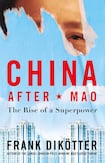
China under communism has long been a notoriously difficult country to gather and collate accurate data and information on, not least because of the ruling party’s secrecy and a widespread self-serving fudging of figures.
Frank Dikötter, in his research for this history of the People’s Republic since Mao Zedong’s death, benefited from an unprecedented opening-up of party archives from 1996 on, which lasted until Xi Jinping’s accession to power a decade ago. It’s an ironic detail, given that China After Mao covers the period marked by Deng Xiaoping’s vaunted “reform and opening up” that would ultimately change China irrevocably.
Dikötter, a Hong Kong-based Dutch historian, has previously published a trilogy of books charting Chinese history since the coming to power of the Communist Party in 1949. These include Mao’s Great Famine, which won the Samuel Johnson Prize in 2011.
It is not terribly surprising that this new book by a fierce critic of the CCP continues in the same vein. What is interesting is how Dikötter maintains that, despite its new embrace of markets and capitalism, the party has remained much the same entity it had been in the 30 years he chronicled in the previous three books.
READ MORE
Dikötter’s detractors have charged him with being overly prosecutorial in his previous work. There is certainly little letting up in that respect here, but the book doesn’t lack nuance.
The Chinese Communist Party derives much of its popular legitimacy from the economic progress the country has made in the past four decades; clearly with this in mind, the book leans heavily on economics. The result means some general readers might find China After Mao a little dry, but it’s hard to fault Dikötter’s patient, thoroughly documented exegesis of Beijing’s economic claims and the often dubious methods that underpin them.
Many observers of China tend to view Mao’s death in 1976 and the end of the Cultural Revolution, coupled with the subsequent conviction of his widow Jiang Qing and the rest of the Gang of Four on treason charges, as a demarcation point. For Dikötter, however, it simply marked a change of strategy for the party, which continued to maintain a jealous grip on power, periodically clamping down on dissent – most notoriously, during the Tiananmen crackdown in 1989 – and being for the most part suspicious of the capitalist mechanisms that turned China into a factory for the world.
The Communist Party leaders throughout the 1980s and 1990s are shown as having a staggering ignorance of basic economics (these are the observations of foreign contemporaries, rather than Dikötter himself) and we see that China’s economic miracle is also something that took a long time coming.
The country was still struggling badly in the early 1990s when Deng made his famous “southern tour” and it later sailed dangerously close to the wind after both the 1998 Asian economic crisis and the global one in 2008 – the latter a point that is largely absent from most appraisals of that particular event.
China’s pivot to exports and its accession to the World Trade Organisation in 2001 were the catalyst for the economic boom but, in Dikötter’s telling, the development has often been illusory, fuelled largely by investment, with China’s growth targets being dutifully met, often thanks to creative accounting.
Some of the same old problems remain too. Not even the consolidation of industry into large state-owned conglomerates from the late 1990s on has solved a long-standing issue of over-capacity and inefficiency.
Corruption also continues to be rife (though occasionally reined in for political reasons, as has been the case with Xi Jinping’s rise to power), with provincial party bosses using local banks effectively as ATMs to fund infrastructure projects. This feeds into the current liquidity crisis of many banks as China’s property sector has slowed considerably.
Western commentators who hoped economic liberalisation would lead to democracy have been disappointed and foreign investors in China have bristled at the government’s restrictive oversight and lack of respect for intellectual property law. The United States, having long viewed China as a currency manipulator, has in recent years begun to show more assertiveness in trade relations with Beijing.
The Communist Party has all this while tightened its grip on power. A combination of propaganda, prosperity and online surveillance has, Xinjiang and Tibet aside, ensured it can do so without resorting so often to overt violence such as the June 4th crackdown, which Dikötter narrates in incredibly vivid detail.
The looming economic and demographic storm clouds that now present a new challenge to the party’s supremacy are treated only in passing here, but as Dikötter outlines, there is nothing the Chinese Communist Party is more adept at than self-preservation.














